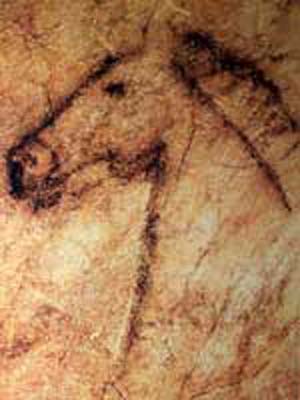The Tito Bustillo cave complex on the Atlantic coast near Ribadesella, Spain, contains works of paleolithic art on a par with those of Altamira and Lascaux. Horses, reindeer, bison, aurochs, female figures, each drawn within its own space according to the artist's intent. For these clearly were not casual or amateur works: They are too sophisticated, and the caves are too deep and too dark. Meanings about which we can only speculate. Layers of paintings on top of one another in the largest cavern: sequential interpretations of the human world across the ages? The continual improvement of the cathedral? Commenting on previous work?
The most important material -- the human figure, sexual symbols -- is hidden away at the back of the cave, in side caverns, hard to find but indicated by discreet marks in red, painted along the passageway.
The creation of these paintings captured my imagination as I stood before them. To paint within a circle of light, when all around you is silence and darkness, except perhaps for the murmur of the subterranean river. To render not from a live model but from your imagination and memory, and to do so so accurately. To not have a flat surface but rather the irregular and quasi-three-dimensional surface of a cave wall curving upward. The dim firelight from the lamp in your hand wavering in the air, unsteady, flickering, making the image move even as it is created.
Red dots and outlines of hands dating back 40,800 years are records of the human (neanderthal?) instinct toward pictorial creation. These are possibly the beginnings of recorded communication. But the animals in Tito Bustillo signify much more, being truly artistic renditions. A male and female deer face each other, intertwined. A curve in the rock face is used to emphasize a neck or a haunch. Using color: black, red, white, even purple. Painting images on top of images, not obliterating but enhancing, interpreting. Leaving pentimenti.
My reaction is not so much awe as confirmation. The instinct to communicate through painting. The fascination with the materials and means at hand. The desire to improve, either one's own work or that which has come before. The joy of a curve. The creativity of a dot. Realism, impressionism, minimalism, abstraction, all present so long ago.

No comments:
Post a Comment